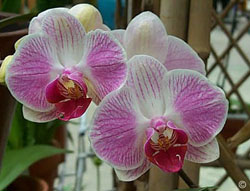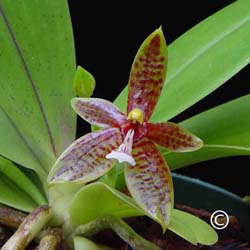 Phalaenopsis, native to tropical Asia, are commonly called moth orchids, named for gently arching, flowering stems with flat flowers which resemble moths in flight. The blossom size and number of flowers per stem vary by variety. They come in all colors except blue and true red, but are most often delicate pastel shades. In their native habitat, they are epiphytes, meaning that they grow attached to tree branches in diffused light. Their abundant roots are white or silvery, and their leaves are broad and flat.
Phalaenopsis, native to tropical Asia, are commonly called moth orchids, named for gently arching, flowering stems with flat flowers which resemble moths in flight. The blossom size and number of flowers per stem vary by variety. They come in all colors except blue and true red, but are most often delicate pastel shades. In their native habitat, they are epiphytes, meaning that they grow attached to tree branches in diffused light. Their abundant roots are white or silvery, and their leaves are broad and flat.
How much light does a phalaenopsis need?

Phalaenopsis orchids like moderate to low light situations, such as an east or north window, bright diffused sunlight, or broad-spectrum fluorescent lights.
How should I plant a phalaenopsis?
Use a commercially available potting mix for epiphytic orchids or make one of medium grade redwood bark chips, hardwood charcoal, coarse peat moss and perlite. Keep the potting mix evenly moist and let it dry slightly between waterings. It is important that the potting mix drain very well to prevent root rot.
What temperature do phalaenopsis’ thrive in?
These orchids also like typical household temperatures. Keep them at 65 to 75 degrees Fahrenheit during the day and 55 to 60 degrees at night. Encourage mature plants to form buds by giving them two months of evening temperatures down to 50 degrees in the fall.
Do phalaenopsis’ do well in the humidity?
These plants will thrive in 50 to 80 percent relative humidity. Increase humidity with a room humidifier or by placing the pot on a tray filled with pebbles and water. Keep the water level in the tray below the bottom of the pot to prevent water wicking into the pot which, over time, may lead to root rot. Over watering results in death of the orchid.
Should I repot an orchid?

Repot these orchids every two to three years when new roots begin to develop. Some varieties produce plantlets on the flowering stems that can be removed and potted after they develop a few roots.
Should I do anything when a new growth is forming?
When new growth is forming, fertilize these plants monthly with a water-soluble commercial orchid formulation, or use a 20-20-20 formulation. Don’t move or prune once buds appear. However when ¾ buds have opened the plant can be moved once.
How often do phalaenopsis’ bloom?
Phalaenopsis generally bloom only once a year, but the season of bloom varies by species or hybrid. With proper selection, you can have moth orchids in flower all year. Flowering stems will usually produce secondary flowering stems if cut back just below the first flower.
Do phalaenopsis’ attract pests?
Phalaenopsis occasionally attract pests, including mealybugs and scale insects. They also are susceptible to viral infections and root rot.
For “Viruses in plants” refer to message number 1443.
For more information, see the following Planttalk Colorado™ video(s).
For more information, see the following Colorado State University Extension fact sheet(s).
- Insect Control: Soaps and Detergents
- Insect Control: Horticultural Oils
- Greenhouse Plant Viruses (TSWV/INSV)



